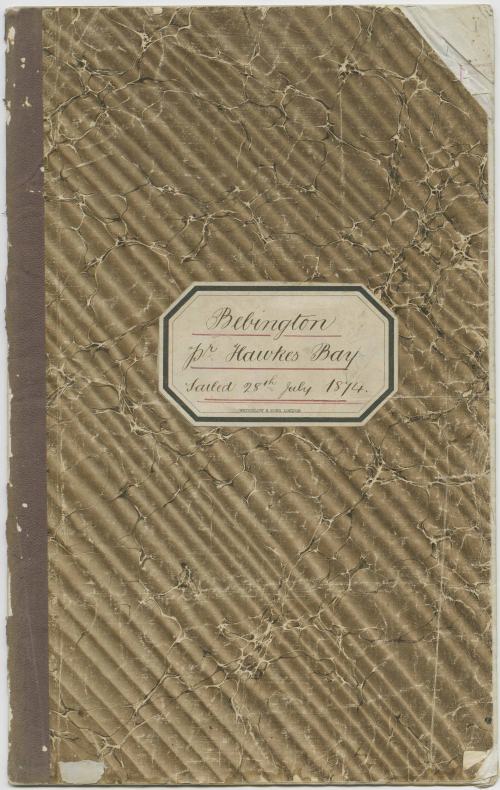
Rough journey for early immigrants

A fascinating collection of immigration archival material from the 1870’s-1880’s, including passenger lists, medical journals and letters, was found in the Browning Street Police Station’s ceiling when it was being dismantled. Thankfully those-in-charge perceived the archives’ historical value and took them to the Hawke’s Bay Art Gallery and Museum (now MTG Hawke’s Bay). These records, which contain a wealth of information about our colonial past, have proven a goldmine for researchers.
During the 1870s hundreds of immigrants set sail from England to Aotearoa. Colonial Treasurer, Julius Vogel’s ambitious vision of assisted immigration recruited workers from Northern Europe as well as the United Kingdom. Initially there was little interest, until 1873 when the adult fare was waived and an immigrant, once resident in New Zealand, could nominate friends and relatives to come and settle.
On Friday afternoon 20 November 1874, the Bebington arrived in Napier after a voyage of 117 days. On board were 317 immigrants, including 60 single women, all “in the bloom and beauty of youth”. Among them was Canadian Lydia Phillips, (28) travelling with her two brothers.
Built in 1859 the Bebington was commonly known as an “old tub” and had the undesirable reputation of being the slowest to make the voyage direct to Aotearoa.
Working conditions on board were considered “rough and dangerous”, especially the wheel which was “so high up” the steersman could easily be thrown overboard. This almost happened when on 29 October, during a severe gale, huge waves swept over the deck injuring two sailors at the wheel and causing damage to the ship.
The Bebington’s captain was W Knight assisted by Dr Dale and matron Hannah Jones. On board, the immigrants were strictly segregated into three groups: married couples, single men and single women (whom the matron chaperoned). Four births and four deaths occurred during the voyage. Of those who died, three were infants, the fourth being a sailor Edward French, found dead while at work with his arm clasped round the yardarm high above the deck – his sailor friends reported he “died in harness”.
Immediately on arrival, one of Lydia’s brothers (on her behalf) lodged a complaint of harsh treatment by the captain and doctor, which they both empathically denied. An enquiry was held before the Immigration Commissioner. Reporters were forbidden to attend the enquiry and the “definite complaints were not made public”. However, the main charge accused Captain Knight of placing Lydia in “irons and keeping her there for a fortnight.”
Tucked in the back of the Bebington’s medical journal is a summary of events leading-up to Lydia’s incarceration, signed by both captain and doctor. The contents state that Captain Knight was informed about Lydia keeping a diary detailing events of the voyage. When Dr Dale demanded she hand it over, Lydia refused and using “most foul and abusive language threatened to strike him or anyone that attempted” to take it from her. According to the newspaper Lydia concealed the diary “about her person” until she was “seized, tied-up and stripped” and the diary removed.
When restrained and forced into irons she became “very violent” making a “tremendous uproar.” The matron’s berth, (no larger than a small person lying down) was turned into a make-shift prison by the ships carpenter. Once complete, Captain Knight checked there was adequate ventilation for survival and instructed the prisoner be incarcerated.
Contrary to newspaper evidence that she was constrained for a fortnight, the captain stated that “the following day” Lydia was removed from her prison because the berth was required for an invalid. She was taken back to the single women’s compartment with instructions she would be escorted onto the poop (small deck located at the back of a ship) for a few hours of fresh air each day.
Captain Knight alleged that Lydia and her brothers had given trouble from the beginning of the journey, when they found out they were to be separated. The siblings were adamant that before boarding, the “Government had led them to suppose” that they could spend each day together. However strict rules onboard disallowed the groups to mingle.
Lydia ignored these rules roaming “where she liked”, particularly disregarding instructions that single women were only allowed onto the poop. When chastised she became unrepentant and insolent. The captain threatened to inform the Napier Immigration Commissioner of her “repeated willful misconduct, causing dissention among the passengers as well as creating trouble for his crew”.
On 17 December Lydia’s case went in front of Napier’s Supreme Court. Captain Knight, too ill to attend, settled “out of court” paying Lydia £30 equivalent to $8,700 today.
During the same month, Captain Knight’s name again appeared in the newspaper when he accused five of Bebington’s sailors of refusing to “obey lawful commands.” At the Resident Magistrates Court, each sailor admitted the offence citing mitigating circumstances - they had been badly treated, threatened and excessively punished over simple misdemeanors. One had been put in irons for “grimacing” when forbidden to communicate with immigrants.
Each was given a three-month prison sentence with hard labour. Such was the sailors dislike of Captain Knight that, when offered a trip to the next port in the Bebington “working or idle”, they refused, one citing that if they went “it would be in the capacity of ballast.”
At the beginning of February 1875, Captain Knight, while travelling to Melbourne on board the Tararua, died of dropsy and heart disease.
Published in the Hawke’s Bay Today newspaper on 25 November 2023 and written by Gail Pope, Social History Curator at MTG Hawke’s Bay.
Image: Bebington Immigration records, 1874
27 November 2023



